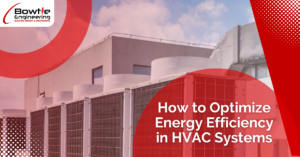BENEFITS OF READING THIS BLOG
- Learn practical tips to optimize energy efficiency in HVAC systems.
- Reduce energy consumption and lower utility costs.
- Improve environmental sustainability by minimizing energy waste.
- Enhance indoor comfort and air quality through efficient HVAC operation.
Introduction
Optimizing energy efficiency in HVAC (Heating, Ventilation, and Air Conditioning) systems is crucial for businesses and homeowners in the United States. By implementing energy-saving strategies, it is possible to reduce energy consumption, lower utility costs, improve indoor comfort, and promote environmental sustainability. This article will explore practical tips and strategies to optimize energy efficiency in HVAC systems. From proper sizing and regular maintenance to utilizing advanced technologies and involving building occupants, every step plays a crucial role in achieving energy efficiency. By implementing these measures, businesses and homeowners can reap long-term benefits in terms of cost savings, improved indoor air quality, and reduced environmental impact.

Understanding HVAC System Energy Efficiency:
To optimize energy efficiency in HVAC systems, it is essential to understand how these systems consume energy and the relevant energy efficiency ratings and standards. HVAC systems account for a significant portion of energy consumption in commercial and residential buildings in the United States. By improving the efficiency of these systems, businesses, and homeowners can achieve substantial energy savings and contribute to a greener future.
Key Strategies to Optimize Energy Efficiency:
1. Proper HVAC System Sizing and Load Calculation:
Properly sizing HVAC systems based on the specific heating and cooling needs of a building is essential. Oversized or undersized methods can result in energy waste and reduced efficiency. Conducting accurate load calculations and considering factors such as insulation, building orientation, and occupancy helps determine the appropriate system size.
2. Regular Maintenance and Cleaning:
Regular maintenance of HVAC systems ensures optimal performance and energy efficiency. Cleaning or replacing air filters, inspecting and cleaning coils, checking refrigerant levels, and calibrating thermostats are all essential maintenance tasks that should be performed at recommended intervals.
3. Upgrading to Energy-Efficient Equipment:
Consider upgrading older, inefficient HVAC equipment with newer, energy-efficient models. Energy-efficient HVAC systems often have advanced features such as variable speed motors, intelligent controls, and improved insulation. These upgrades can result in significant energy savings over time.
4. Implementing Smart Thermostat Controls:
Smart thermostats allow for precise temperature control, scheduling, and remote management. Smart thermostats help reduce unnecessary energy consumption and improve comfort levels by optimizing temperature settings based on occupancy and activity patterns.
5. Optimizing Air Distribution and Ventilation:
Proper air distribution and ventilation play a crucial role in HVAC system efficiency. Ensuring balanced airflows, sealing ductwork to prevent leaks, and utilizing demand-based ventilation systems can help optimize energy usage and indoor air quality.
Energy-Saving Practices for HVAC System Operation:
In addition to the critical strategies mentioned above, adopting energy-saving practices in the day-to-day operation of HVAC systems can further optimize energy efficiency:
1. Temperature and Setback Optimization:
Adjusting temperature settings based on occupancy and implementing setback strategies during unoccupied hours can lead to significant energy savings.
2. Utilizing Natural Ventilation and Daylighting:
Leveraging natural ventilation and utilizing daylighting techniques can reduce the need for mechanical cooling and lighting, thereby saving energy.
3. Managing Humidity Levels Effectively:
Controlling humidity levels in a building is essential for occupant comfort and energy efficiency. Proper humidity control reduces the workload on HVAC systems and improves their overall performance.
4. Ensuring Proper Insulation and Sealing:
Well-insulated buildings with proper sealing minimize heat transfer, reduce energy loss, and improve HVAC system efficiency.
5. Monitoring and Adjusting Air Filters:
Regularly monitoring and cleaning or replacing air filters can improve airflow, reduce strain on the system, and enhance energy efficiency.
Advanced Technologies for Energy Efficiency:
Advancements in technology have introduced various solutions that can further optimize energy efficiency in HVAC systems:
1. Variable Speed Drives and Modulating Controls:
Variable speed drives adjust the speed of HVAC system components based on demand, allowing for precise control and improved energy efficiency. Modulating controls provides gradual adjustments, ensuring optimal performance.
2. Heat Recovery and Energy Recycling Systems:
Implementing heat recovery and energy recycling systems allows the capture and utilization of waste heat, resulting in energy savings and improved system efficiency.
3. Building Automation and Energy Management Systems:
Building automation systems integrate various HVAC components, lighting, and other systems, optimizing energy consumption based on real-time data and pre-defined settings.
4. Demand-Based Ventilation and Occupancy Sensors:
Demand-based ventilation systems adjust airflow based on occupancy levels, improving energy efficiency. Occupancy sensors help optimize energy usage by activating or deactivating HVAC systems in response to occupancy changes.
The Role of Building Occupants in Energy Efficiency:
Building occupants play a crucial role in achieving energy efficiency. Educating occupants about energy-saving practices, encouraging responsible usage of HVAC systems, and promoting energy awareness contribute to overall energy efficiency goals.
Case Studies: Successful Energy Efficiency Upgrades:
Examining real-life examples of energy efficiency upgrades in HVAC systems provides valuable insights and inspiration for implementing similar measures. Case studies highlight the energy savings achieved, return on investment, and lessons learned from successful projects.
Conclusion:
Optimizing energy efficiency in HVAC systems is an innovative and responsible approach for businesses and homeowners in the United States. By implementing the outlined strategies, adopting energy-saving practices, and leveraging advanced technologies, significant energy savings can be achieved while improving indoor comfort and reducing environmental impact. Embracing energy efficiency in HVAC systems is not only beneficial for cost savings but also contributes to a sustainable future. Let’s take the necessary steps to optimize energy efficiency and positively impact our buildings, communities, and the planet.
 Skip to content
Skip to content
